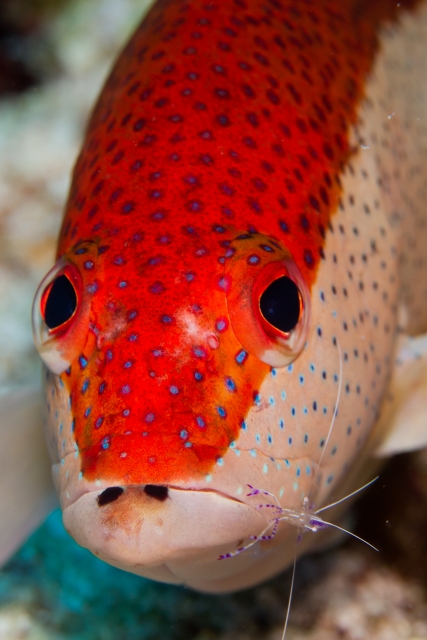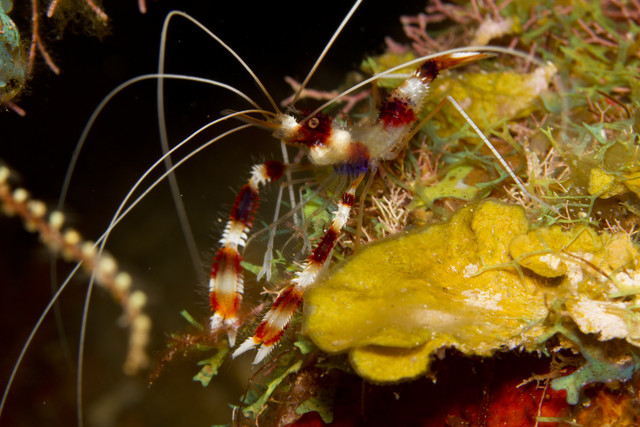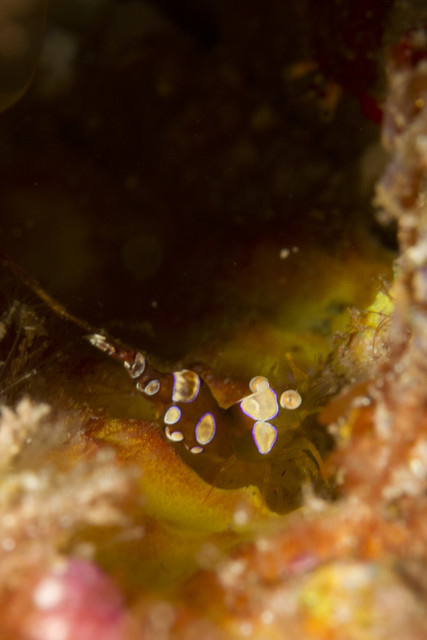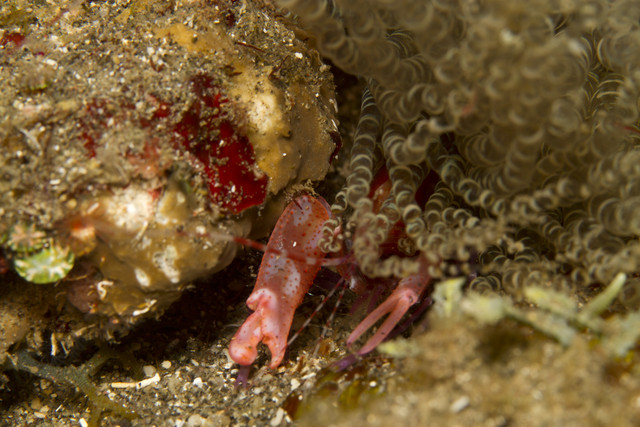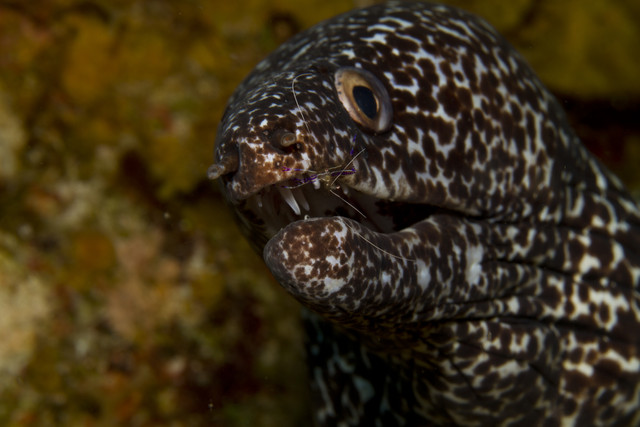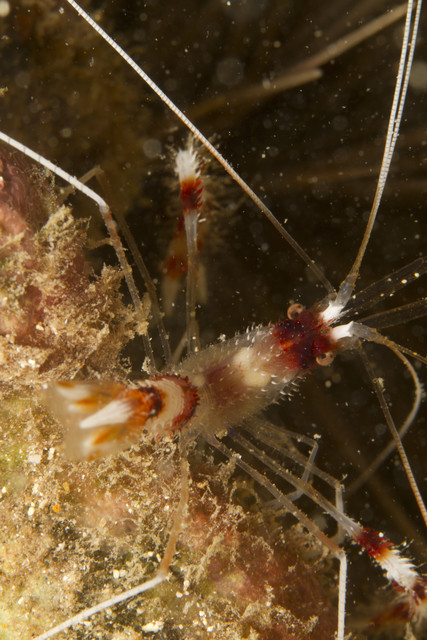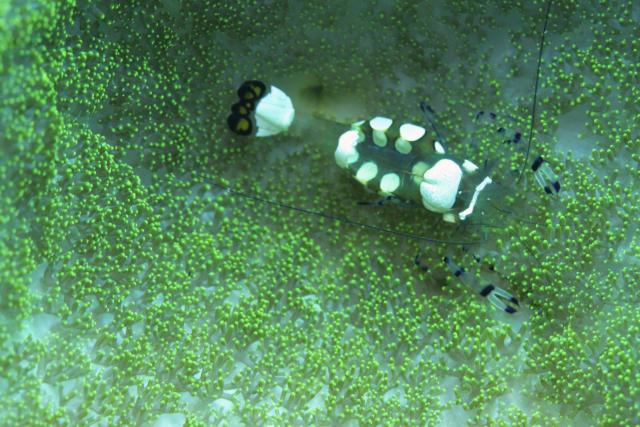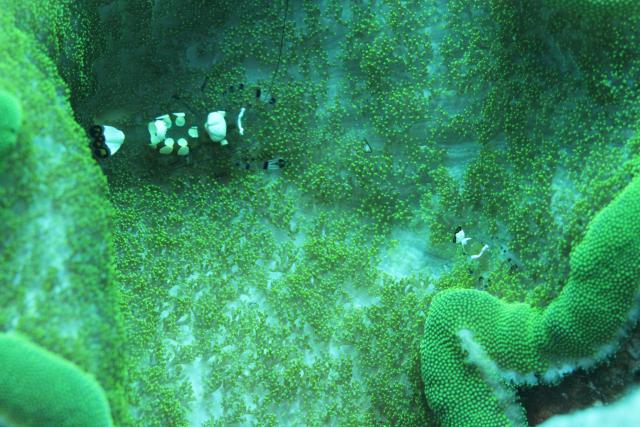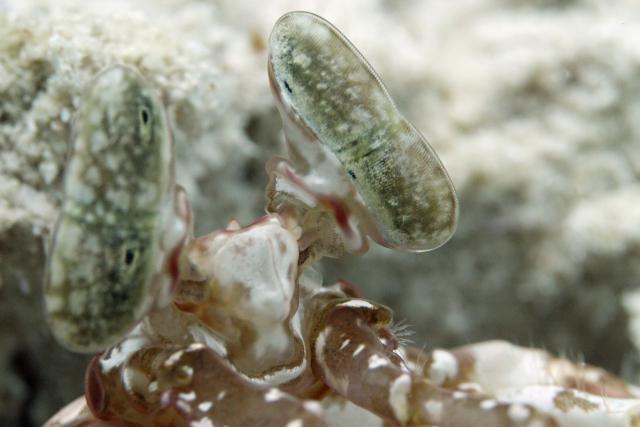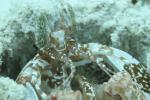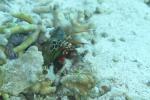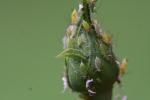shrimp
Turks and Caicos Explorer: More Reef Dentistry
ktuli — Wed, 11/14/2012 - 20:59
Sorry - been a little lax with posting, so I'll try and get back to sharing photos from the trip more regularly. I still have about seven more dives to process the photos from.
Last year, I shared a shot of a Pederson's Cleaner Shrimp on a Spotted Moray Eel. Well, this year, I caught one on a Coney.
Technical Data: Canon EOS 7D, Canon EF 100mm f/2.8L Macro IS USM, 1/200th sec at f/11. Image Stabilization on. ISO 160. Ikelite Housing and Port with Ikelite 161 Strobe in TTL Mode. Raw conversion and cropped in Photoshop CS5.
- Bill
Caribbean Explorer: Another Banded Coral Shrimp
ktuli — Tue, 11/15/2011 - 19:03
I know I've already shared a shot of a Banded Coral Shrimp (Steopus hispidus), but I figured I'd share another since this one gives a bit better of an angle to see the details on the shrimp...
Technical Data: Canon EOS 7D, Canon EF 100mm f/2.8L Macro IS USM, 1/120th sec at f/16. Image Stabilization on. ISO 200. Ikelite Housing and Port with Ikelite 161 Strobe in TTL Mode. Raw conversion in Photoshop CS5.
- Bill
Caribbean Explorer: Squat Anemone Shrimp
ktuli — Thu, 11/03/2011 - 18:12
Ok - it has been a little while since I've shared any shrimp photos, so let's get right to it...
This little critter is a Squat Anemone Shrimp (Thor amboinensis) - or as they are more commonly known.... a Sexy Shrimp (yes, that link does indeed go to sexyshrimp.com!).
They get that name from their tendency to hold their abdomen up and do a little dance of waving their abdomen back and forth.
Unfortunately - no, I did not shoot the video.
Supposedly, these little (about 3/4") shrimp are common in both the Indopacific (ie: Wakatobi) and in the Caribbean. However, this one is the first one I've ever seen. They're pretty popular in the pet trade - and you can plainly see why with their bright colors, interesting patterns, and comical behaviors.
The photo isn't the greatest - the shrimp was hiding down in a hole, and I didn't have anything to anchor myself on, so I wasn't able to use the manual focus adjustment knob, so I had to kind of trust the AF selection and fire the shot off at the right time. Looks like my focus is just a tad off. I also cropped down for the close-up view - mouseover the image for the original.
All in all though, this is definitely an awesome find and a fun species to photograph. I'm already looking forward to another opportunity to do so!
Technical Data: Canon EOS 7D, Canon EF 100mm f/2.8L Macro IS USM, 1/120th sec at f/16. Image Stabilization on. ISO 200. Ikelite Housing and Port with Ikelite 161 Strobe in TTL Mode. Raw conversion and cropped in Photoshop CS5 (mouseover for original).
Caribbean Explorer: Red Snapping Shrimp
ktuli — Sun, 10/30/2011 - 20:34
Today's subject is an interesting one... It is called a Snapping or Pistol Shrimp (Alpheus armatus). As you can see in the shot below, they have that one larger claw - but I'll let the video explain why that is cool. These guys were somewhat easy to find on the reef because they usually were found hiding underneath the Corkscrew Anemone (Bartholomea annulata). Unfortunately, that also made them difficult to photograph as they usually were partially obscured, and there was plenty of other things for the AF system to pick up.
Technical Data: Canon EOS 7D, Canon EF 100mm f/2.8L Macro IS USM, 1/120th sec at f/16. Image Stabilization on. ISO 100. Ikelite Housing and Port with Ikelite 161 Strobe in TTL Mode. Raw conversion in Photoshop CS5.
I didn't take the following video (though I certainly wish I worked for the BBC), but take a minute or so and see just how impressive that tiny little claw is...
Pretty obvious where the name comes from, huh?
- Bill
Caribbean Explorer: Reef Dentistry
ktuli — Tue, 10/18/2011 - 19:12
You know - when you get something stuck in your teeth, it is so easy to just grab a toothpick and take care of that. But what about when you're 40ft underwater? And what about if you're an eel, and you have no arms?
Well, there's a solution for that too...
Just make a visit to your friendly neighborhood cleaning station. This particular one is operated by a Pederson's Cleaner Shrimp (Periclimenes pedersoni).
This Spotted Moray Eel (Gymnothorax moringa) apparently needed to have something removed from those large fangs, and didn't mind posing for me while doing so.
Mouseover the image for a cropped version showing the Pederson's Shrimp at work.
Technical Data: Canon EOS 7D, Canon EF 100mm f/2.8L Macro IS USM, 1/120th sec at f/16. Image Stabilization on. ISO 100. Ikelite Housing and Port with Ikelite 161 Strobe in TTL Mode. Raw conversion in Photoshop CS5.
I have plenty more shots of eels and shrimp separately, but capturing this kind of reef behavior is always a special treat.
- Bill
Caribbean Explorer: Banded Coral Shrimp
ktuli — Sun, 10/16/2011 - 20:40
I'm a sucker for all those tiny reef invertebrates. Shrimp are among my favorites, and I've often seen Banded Coral Shrimp (Steopus hispidus) in the pet trade. So it is quite fun to see them in their natural habitat. Fortunately, I got to see plenty of them on the reefs on this trip.
Technical Data: Canon EOS 7D, Canon EF 100mm f/2.8L Macro IS USM, 1/120th sec at f/16. Image Stabilization on. ISO 100. Ikelite Housing and Port with Ikelite 161 Strobe in TTL Mode. Raw conversion in Photoshop CS5.
Since I got to see so many of them, I'll surely be sharing some more shots of them in the future.
- Bill
Wakatobi: Peacock-tail Anemone Shrimp
ktuli — Sat, 05/14/2011 - 12:44
Sorry - I don't even remember what all I did this week that I didn't get any new posts in, but here's another one from the Wakatobi trip.
I know I shared a slightly different version of this shrimp before, but I figured I would also share this version (which coincidentally is hanging from our walls in an 8x10" format) that has had a little post production work done on it.
Anya spotted this little girl (yes, I know it is a female) early in the one dive, but for whatever reason, no one else in the group got to see it. As soon as she pointed it out to me (and I figured out what she was pointing to!) I moved in and rattled off a ton of shots.
Technical Data: Canon EOS 7D, Canon EF 100mm f/2.8L Macro IS USM, 1/100th sec at f/11.3. Image Stabilization on. ISO 3200 (Auto). Ikelite Housing and Port with Ikelite 161 Strobe in TTL Mode. Removed Color Cast in Photoshop Elements 8.0 (mouseover for original).
The Peacock-tail Anemone Shrimp (Periclimenes brevicarpalis) is only about 1.5" long and lives specifically on carpet anemones where in exchange for keeping the anemone free of parasites and potentially warning off some predators, it receives protection and free meals from the scraps the anemone misses. As I said, I know this is a female because they are much larger than the males - as you can see in the photo below (the male is towards the bottom right).
Technical Data: Canon EOS 7D, Canon EF 100mm f/2.8L Macro IS USM, 1/170th sec at f/11.3. Image Stabilization on. ISO 2500 (Auto). Ikelite Housing and Port with Ikelite 161 Strobe in TTL Mode. No post production.
Unfortunately, this was the only shrimp we saw like this, and any others we saw I didn't manage to get good photos of. Which is a shame, really, because I am very fond of shrimp - especially these tropical ornamental kinds.
- Bill
Wakatobi: Mantis Shrimp
ktuli — Wed, 02/16/2011 - 20:18
What you see here are a pair of the most complex eyes known to man.
Technical Data: Canon EOS 7D, Canon EF 100mm f/2.8L Macro IS USM, 1/170th sec at f/8. Image Stabilization on. ISO 2500 (Auto). Ikelite Housing and Port with No Flash. Removed Color Cast and Auto-Smartfix in Photoshop Elements 8.0.
They belong to a Tiger Mantis Shrimp (Lysiosquillina maculata).
Mantis Shrimp (not related to either Praying Mantis nor Shrimp) were something I had on my checklist of things I wanted to see on this dive trip. And much like the nudibranchs, I was not expecting how often we would see them. I personally saw three individuals, plus evidence of at least two more, and others in the group saw several more individuals. This individual was seen at my personal favorite dive site at Wakatobi - Roma, which was also were my False Clownfish photo came from, and we also saw a Blue Ribbon Eel, a Leaf Scorpion Fish, Nudibranchs, Spine-cheek Anemonefish, Fire Dartfish, and tons more (but you'll have to stop back for those photos). If someone told me I could go back to Wakatobi and dive only one site the whole week, it would probably be Roma that I'd pick.
Anyway, you might be asking why those eyes are the most complex known to man. If you're not, you read that article I linked up there, and actually understood it all (I certainly didn't!). But the short story is this: they can see a much wider spectrum of light from us (spanning from infra-red all the way into the ultra-violet spectrum!), meaning they can see about ten times the number of colors we can, they can see and filter linear polarized light (we need sunglasses or camera lens filters for that), and some species can even see circular polarized light (also a job for lens filters), and additionally they do not lose depth perception when using only one eye (humans need both eyes for depth perception). Oh yeah, and they rotate independently, stick out from the head (ie: can see around corners), and if my research is correct, can pick up satellite television. Ok, maybe not that last bit, but they're still pretty impressive eyes. Then again, perhaps it isn't as much of an exaggeration after all - an article on Wired.com discusses how the Mantis Shrimp's eyes are being researched to help develop the next new High-Def recording medium (and I haven't even started switching to Blu-ray, and they're obsolete!).
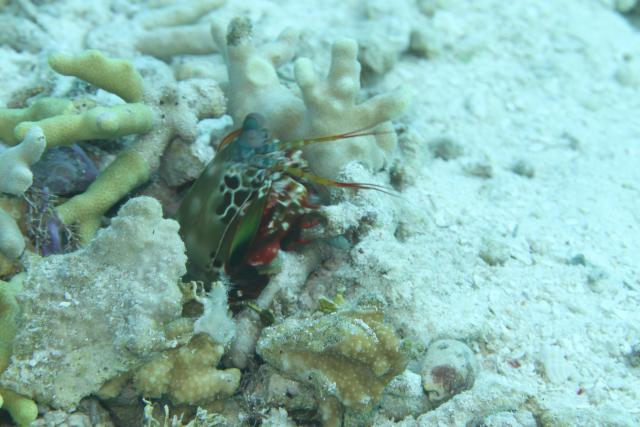
The last guy there is a Peacock Mantis Shrimp (Odontodactylus scyllarus) and is probably considered the more common mantis shrimp. They are sometimes available in the pet trade (and sometimes come into a tank as an unexpected hitchhiker on coral or live rock). They are much more colorful, thus their names.
In fact, I get to take credit for finding that guy on that particular dive (which was at a site called 'The Zoo'). I saw his burrow from about twenty feet away, and quickly made my way there. As I got close, I thought I had seen something duck inside, so I glanced into the hole (literally just a hole in the ground that drops about a foot deep, then branches off to the side) but didn't see anything. So I settled in on the sand and waited and watched. After a few minutes, Brigette (one of our dive instructors) came over and tapped me on the shoulder - which made me jump (I will explain why shortly). She asked what I was looking at, and I tried to explain that I wasn't quite sure if there was anything there or not. But she settled in next to me to wait too. No more than a few seconds later, the Peacock Mantis Shrimp returned to the top of his burrow and did some housekeeping, throwing a piece of broken coral out. I fired off a few frames. I was thrilled, but running low on air, so I passed the camera off to Anya and tried to indicate to her what I had been watching and to get some photos. I must have done a terrible job of explaining what it was, because she said she went over and was looking right down the burrow and trying to figure out what she was supposed to take photos of. Perhaps it was good that she didn't see the Mantis Shrimp, because he probably wouldn't have been thrilled with her getting so close to his burrow.

So why did I jump when Brigette tapped me on the shoulder? Well, as I lay there on the sand staring at this empty hole in the ground, the thought was occurring to me that perhaps the reason it was empty was because the occupant wasn't home. Peacock Mantis Shrimp are roaming hunters, and when they're out of their burrows, they look like the guy to the right (kind of alien, huh?) (Sorry, I did not take that photo - all of the mantis shrimp I saw were in their burrows.)
Still wondering why I might jump? Ok, let me add that some mantis shrimp can grow to 18 inches long! Still not convinced? Let's throw in their hunting styles. There are two styles of mantis shrimp, smashers and spearers. Smashers obviously, as the name implies, simply smash their prey to death; whereas spearers resemble praying mantids more in that they have back-folding raptorial arms they use to impale and hold prey. Still holding out on me, thinking I am a bit too jumpy? How about if I tell you that their attacks have the speed of a .22 caliber bullet - plus are supposed to be able to cause cavitation (causing a voided space in the water, which is then filled, causing a shockwave impact). Having owned a pet store for several years, mantis shrimp were referred to as 'thumb smashers' (I never carried them in my store, but often saw them at distributors). In general, they're nasty little guys. They have the strength to break crab shells, fingers, aquarium glass, and even camera housing lens ports!
Even with all of that, they're still fascinating creatures, and I was thrilled to get to see two different species of them in the wild in their environment, and to bring back photos of both. I look forward to getting even better shots next time!
- Bill
Indonesia: Sneak Peek (part 2)
ktuli — Sat, 01/29/2011 - 03:05
Wow! Just wow!
So far, we have 12 dives in on this trip, and I've been getting more and more fantastic shots. I've been learning how to better use my gear, as well as how to just dive better (ie: better buoyancy control, better air comsumption, etc), but more on all of that later.
We've seen things we've never seen before, and stuff we've only ever seen in books. I have a very small selection to share today, including: some anemone fish, shrimp, crocodile fish, and sea stars. I've also got a good collection of nudibranch shots going, but I'm going to be stingy with those until I get home... ;)
Enjoy these for now:
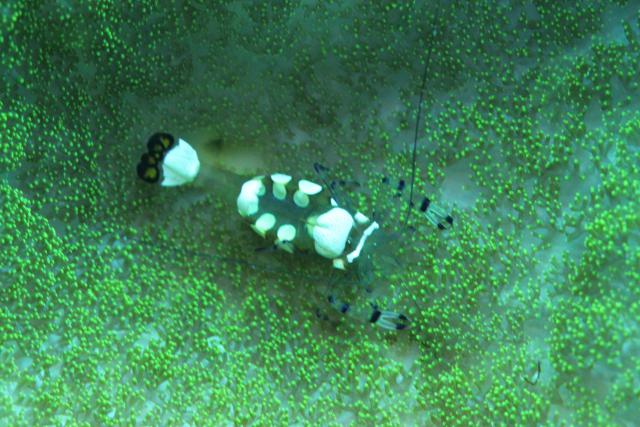
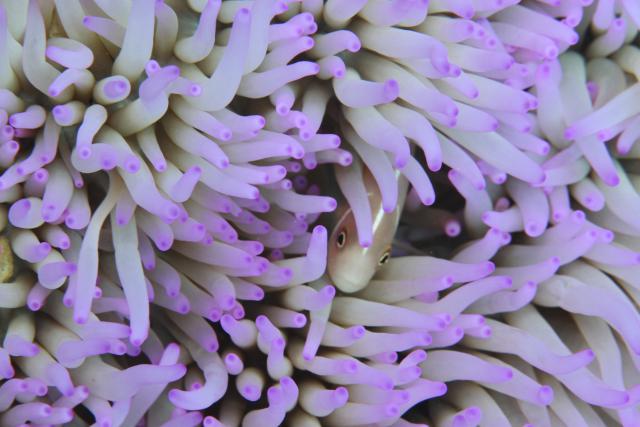
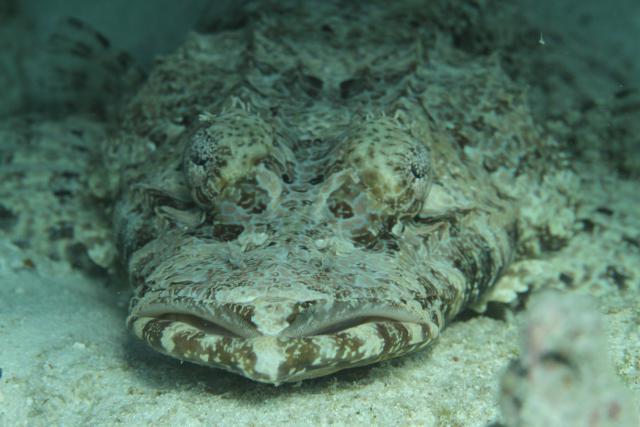
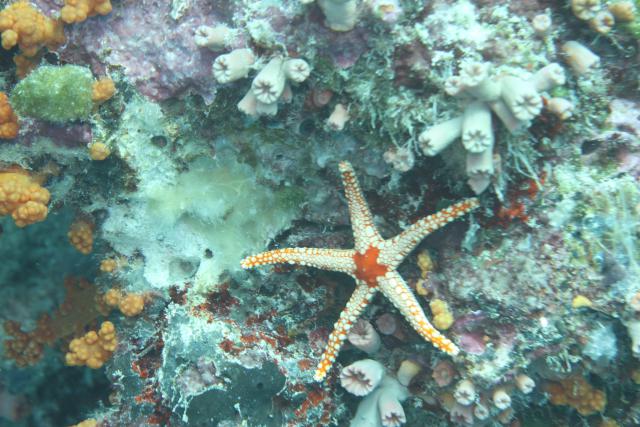
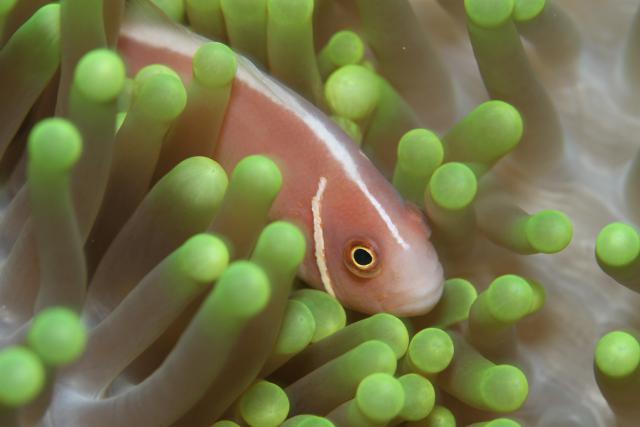
Our afternoon alarm just went off, so we now have to go head out for our second twilight dive!
- Bill

